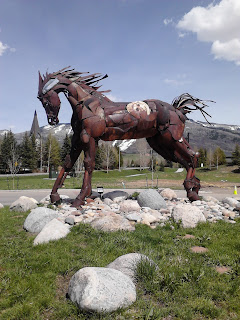Such a long time since I've posted! Busy with many new things. I've started a crafting group on Facebook and some of the participants have asked me to help them learn to sew. It is a huge topic, so I'm planning to break it down into some smaller bite-sized pieces.
Let's start with choosing your sewing machine. Several questions to answer before you go shopping.
First: What kinds of things do you want to make? If you want to do upholstery, it will require a very different machine than making quilts or garments. Perhaps you don't know for certain what to make, if that is the case, a basic entry-level sewing machine might be the best place to start.
Second: What is your budget? A lot of very nice machines can be found at thrift stores*. That being said, an entry level machine can be purchased from a big box store for $100 to $200. I have also done a quick search on Amazon and there are machines available for as little as $20. My personal preference would be to get a machine a little above the base model, since my experience with the very low-end machines has been that they are of very poor quality and need frequent service or replacement.
Third: Find a class or video to learn about your machine and some basic sewing skills. My favorite source for classes is Craftsy.com and there are many beginner classes available. It is a subscription site and the rate for the first year is very reasonable. You can browse many classes in whatever you are interested in learning. There are also many videos on YouTube that you might find helpful as you learn to sew.
*A note on buying from thrift stores. Take someone with you that knows something about sewing machines. The older machines may be missing parts that are expensive or impossible to replace. Many machines land in thrift stores simply because the prior owner couldn't make it work. Please know that it may be necessary to take it to be serviced before it will work properly. I have seen many, many machines in thrift stores for $20 to $100.
 |
| This is my Brother SQ9185 |
A few things I find very helpful on a machine. A self-threading device is great since sewing machine needles thread from a very difficult angle to see easily. The device usually has a tiny hook that passes through the eye of the needle and draws a small loop of thread through the eye. I use a tiny stiletto to catch the loop and pull the thread the rest of the way through the eye of the needle. In the picture, the self-threader is the lever I'm pulling down with my finger. The large hook on the left is a thread guide and the tiny hook for the needle eye is a bit to the right.
A walking foot is great for keeping multiple layers of fabric moving through the machine at the same rate. Especially useful for quilting. These can be integrated into the machine or be an attachment that can be purchased later. In this picture it is an attachment that goes behind the presser foot and has tiny gripping feet that work with the feed dogs below the silver plate to grab the layers of fabric and presses them together so they move as one piece through the machine as it stitches.
Drop in bobbin set up is much easier than the older style of bobbin case used previously. This picture shows the drop in bobbin under the small gray transparent cover.
Free arm is very useful for constructing sleeves, putting up hems on pants and other small circular projects.
Please feel free to get in touch if you have questions or to leave a comment below if you find this useful. I'm spending time learning how to edit video so that I can use that format in the future. Bear with me while I figure out the technology I need to learn for that method.





















